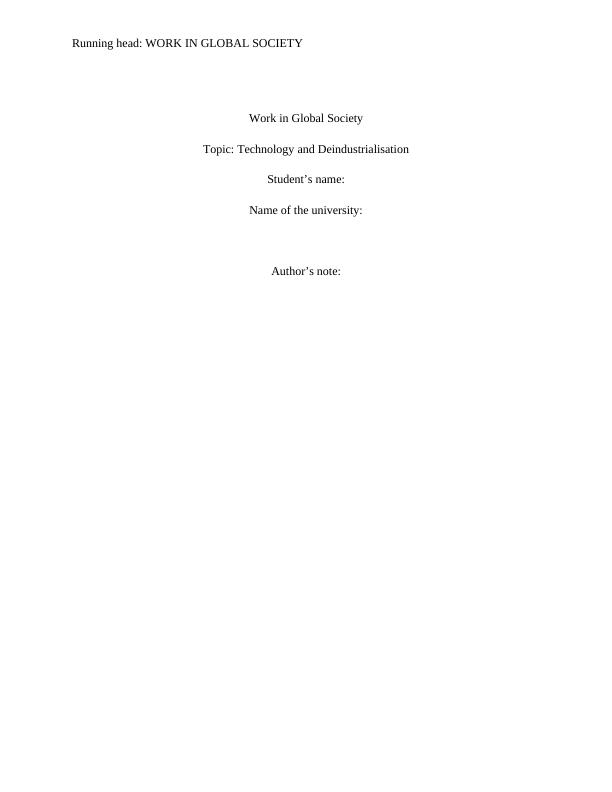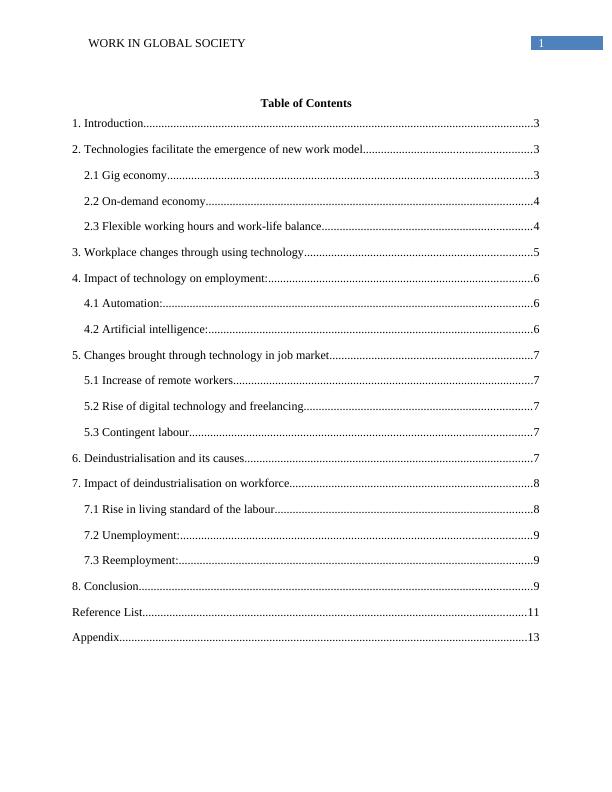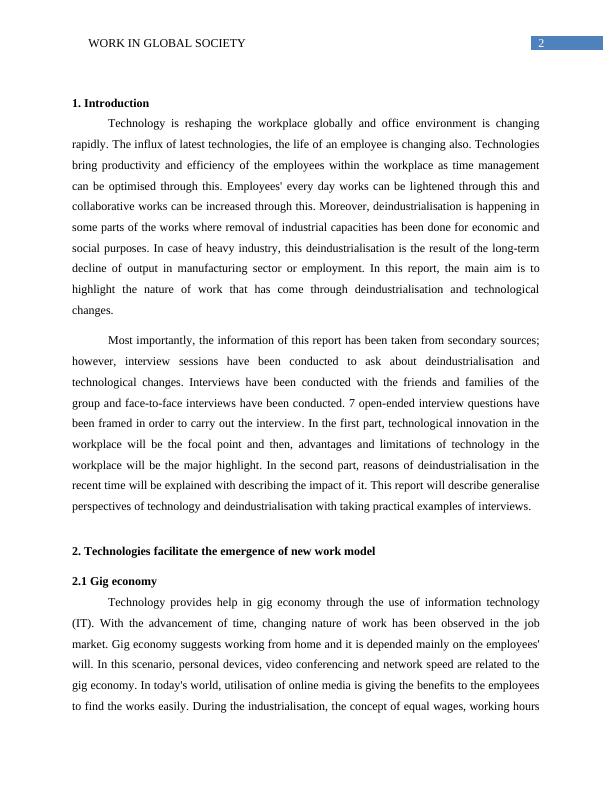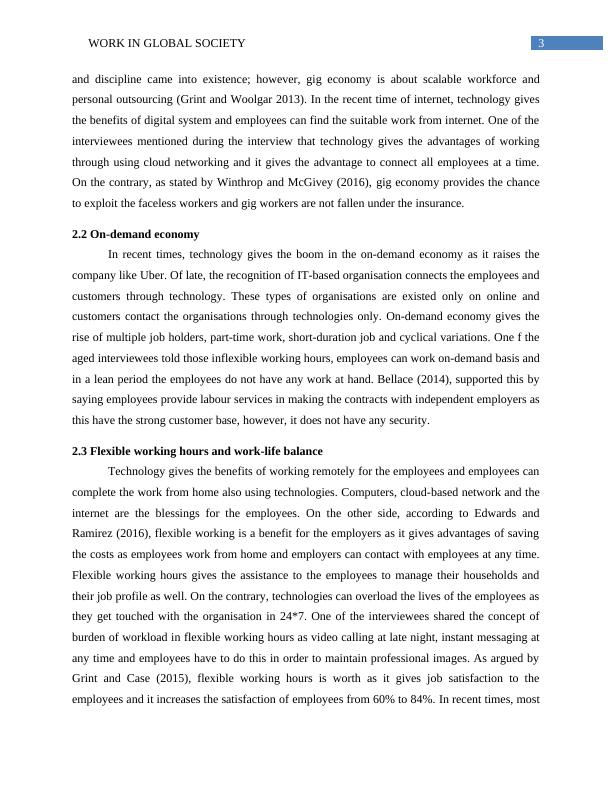Ask a question from expert
Impact of Deindustrialisation on Workforce
13 Pages3783 Words245 Views
Added on 2020-04-01
Impact of Deindustrialisation on Workforce
Added on 2020-04-01
BookmarkShareRelated Documents
Running head: WORK IN GLOBAL SOCIETYWork in Global SocietyTopic: Technology and DeindustrialisationStudent’s name:Name of the university:Author’s note:

1WORK IN GLOBAL SOCIETYTable of Contents1. Introduction..................................................................................................................................32. Technologies facilitate the emergence of new work model........................................................32.1 Gig economy..........................................................................................................................32.2 On-demand economy.............................................................................................................42.3 Flexible working hours and work-life balance......................................................................43. Workplace changes through using technology............................................................................54. Impact of technology on employment:........................................................................................64.1 Automation:...........................................................................................................................64.2 Artificial intelligence:............................................................................................................65. Changes brought through technology in job market....................................................................75.1 Increase of remote workers....................................................................................................75.2 Rise of digital technology and freelancing............................................................................75.3 Contingent labour..................................................................................................................76. Deindustrialisation and its causes................................................................................................77. Impact of deindustrialisation on workforce.................................................................................87.1 Rise in living standard of the labour......................................................................................87.2 Unemployment:.....................................................................................................................97.3 Reemployment:......................................................................................................................98. Conclusion...................................................................................................................................9Reference List................................................................................................................................11Appendix........................................................................................................................................13

2WORK IN GLOBAL SOCIETY1. Introduction Technology is reshaping the workplace globally and office environment is changingrapidly. The influx of latest technologies, the life of an employee is changing also. Technologiesbring productivity and efficiency of the employees within the workplace as time managementcan be optimised through this. Employees' every day works can be lightened through this andcollaborative works can be increased through this. Moreover, deindustrialisation is happening insome parts of the works where removal of industrial capacities has been done for economic andsocial purposes. In case of heavy industry, this deindustrialisation is the result of the long-termdecline of output in manufacturing sector or employment. In this report, the main aim is tohighlight the nature of work that has come through deindustrialisation and technologicalchanges.Most importantly, the information of this report has been taken from secondary sources;however, interview sessions have been conducted to ask about deindustrialisation andtechnological changes. Interviews have been conducted with the friends and families of thegroup and face-to-face interviews have been conducted. 7 open-ended interview questions havebeen framed in order to carry out the interview. In the first part, technological innovation in theworkplace will be the focal point and then, advantages and limitations of technology in theworkplace will be the major highlight. In the second part, reasons of deindustrialisation in therecent time will be explained with describing the impact of it. This report will describe generaliseperspectives of technology and deindustrialisation with taking practical examples of interviews. 2. Technologies facilitate the emergence of new work model 2.1 Gig economy Technology provides help in gig economy through the use of information technology(IT). With the advancement of time, changing nature of work has been observed in the jobmarket. Gig economy suggests working from home and it is depended mainly on the employees'will. In this scenario, personal devices, video conferencing and network speed are related to thegig economy. In today's world, utilisation of online media is giving the benefits to the employeesto find the works easily. During the industrialisation, the concept of equal wages, working hours

3WORK IN GLOBAL SOCIETYand discipline came into existence; however, gig economy is about scalable workforce andpersonal outsourcing (Grint and Woolgar 2013). In the recent time of internet, technology givesthe benefits of digital system and employees can find the suitable work from internet. One of theinterviewees mentioned during the interview that technology gives the advantages of workingthrough using cloud networking and it gives the advantage to connect all employees at a time.On the contrary, as stated by Winthrop and McGivey (2016), gig economy provides the chanceto exploit the faceless workers and gig workers are not fallen under the insurance.2.2 On-demand economy In recent times, technology gives the boom in the on-demand economy as it raises thecompany like Uber. Of late, the recognition of IT-based organisation connects the employees andcustomers through technology. These types of organisations are existed only on online andcustomers contact the organisations through technologies only. On-demand economy gives therise of multiple job holders, part-time work, short-duration job and cyclical variations. One f theaged interviewees told those inflexible working hours, employees can work on-demand basis andin a lean period the employees do not have any work at hand. Bellace (2014), supported this bysaying employees provide labour services in making the contracts with independent employers asthis have the strong customer base, however, it does not have any security.2.3 Flexible working hours and work-life balanceTechnology gives the benefits of working remotely for the employees and employees cancomplete the work from home also using technologies. Computers, cloud-based network and theinternet are the blessings for the employees. On the other side, according to Edwards andRamirez (2016), flexible working is a benefit for the employers as it gives advantages of savingthe costs as employees work from home and employers can contact with employees at any time.Flexible working hours gives the assistance to the employees to manage their households andtheir job profile as well. On the contrary, technologies can overload the lives of the employees asthey get touched with the organisation in 24*7. One of the interviewees shared the concept ofburden of workload in flexible working hours as video calling at late night, instant messaging atany time and employees have to do this in order to maintain professional images. As argued byGrint and Case (2015), flexible working hours is worth as it gives job satisfaction to theemployees and it increases the satisfaction of employees from 60% to 84%. In recent times, most

End of preview
Want to access all the pages? Upload your documents or become a member.
Related Documents
Work and Life in a Global Societylg...
|17
|4623
|35
Gig-Economy and its Impact on Labours - MGMT 2718lg...
|15
|3836
|40
The Gig Economy Article | HR Benefits and Challengeslg...
|14
|3493
|74
Advantages and Negative Implications of the Gig Economylg...
|11
|3163
|322
BUSM4558 Work in Global Society Assignmentlg...
|18
|6229
|199
Sri Lanka's Labour Laws: Urgent Need for Flexibility to Meet Changing Workforce Demands - Policy Brielg...
|6
|2125
|500